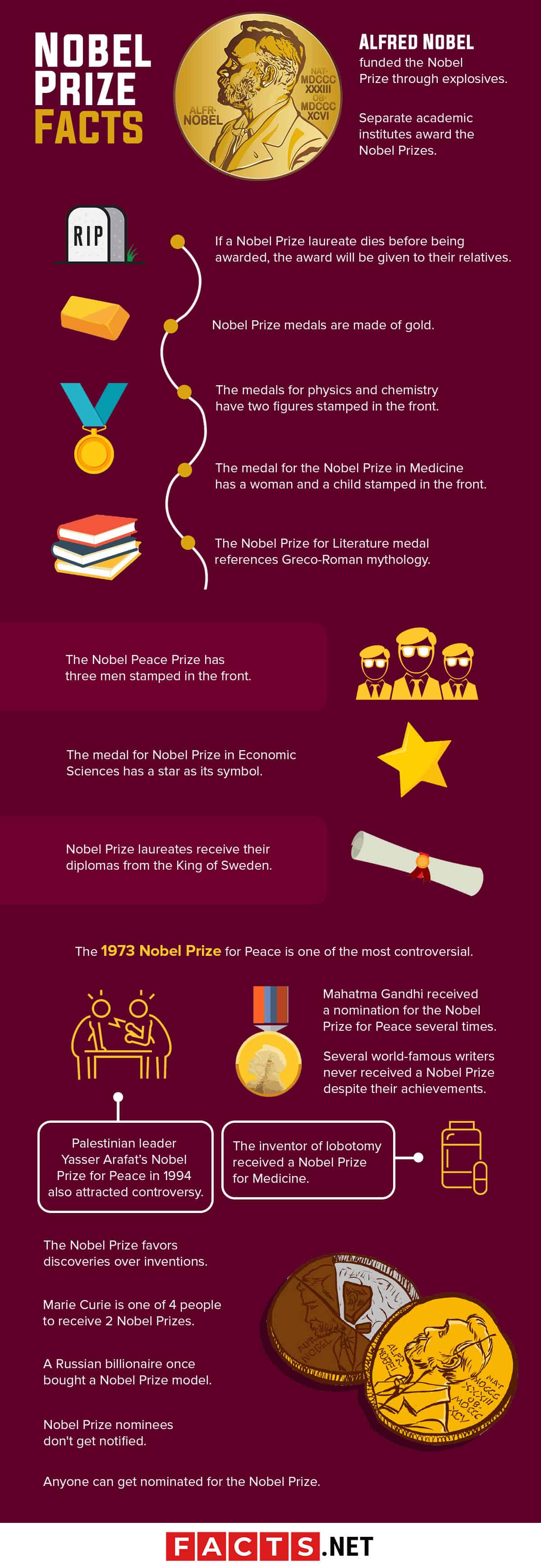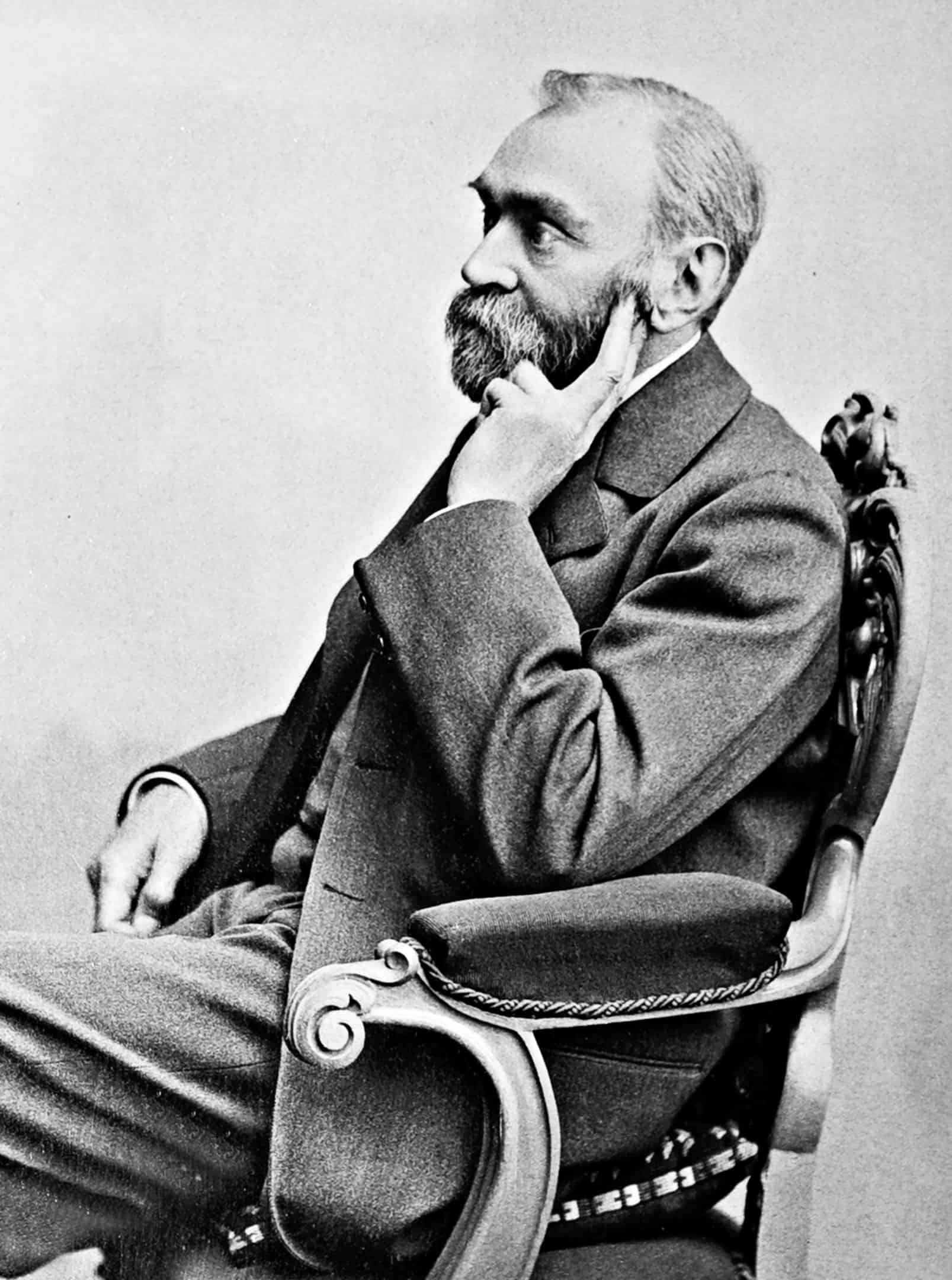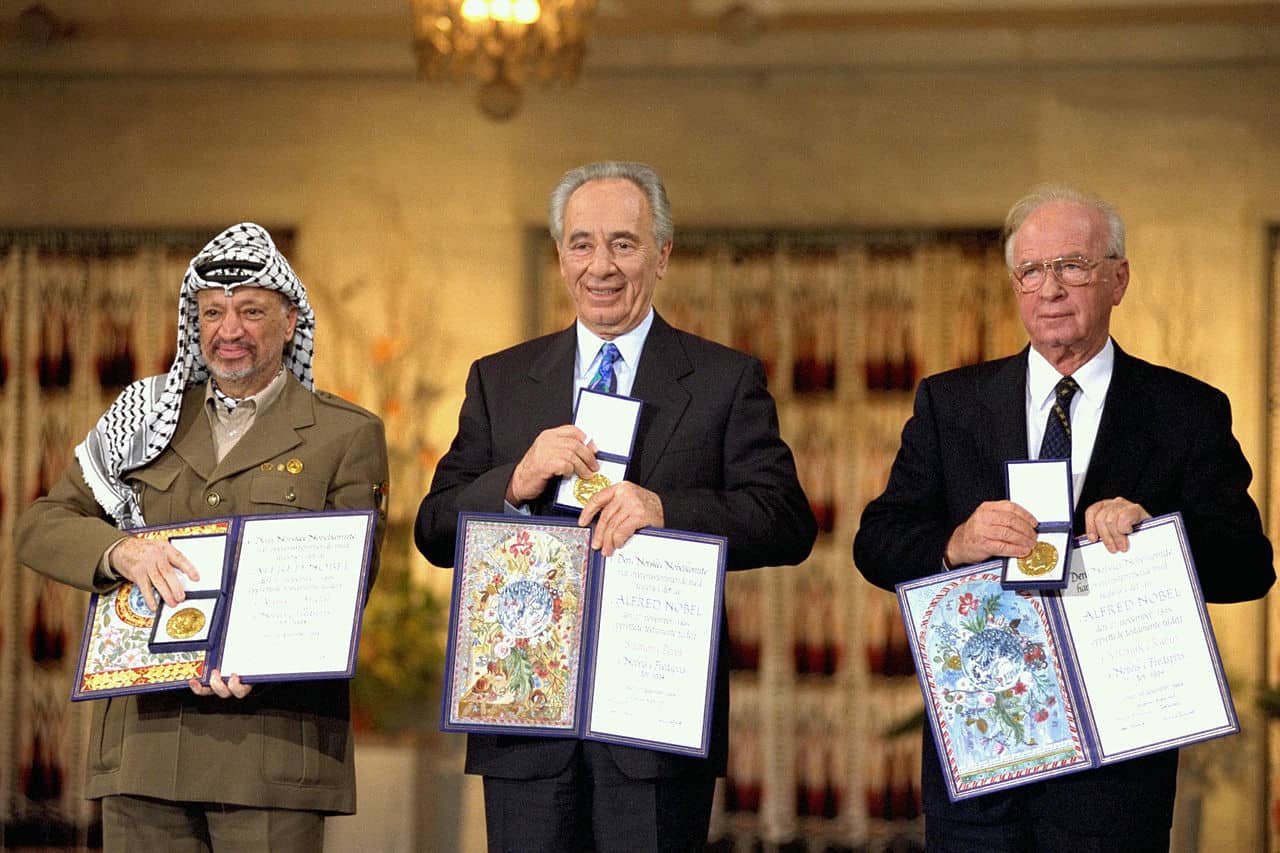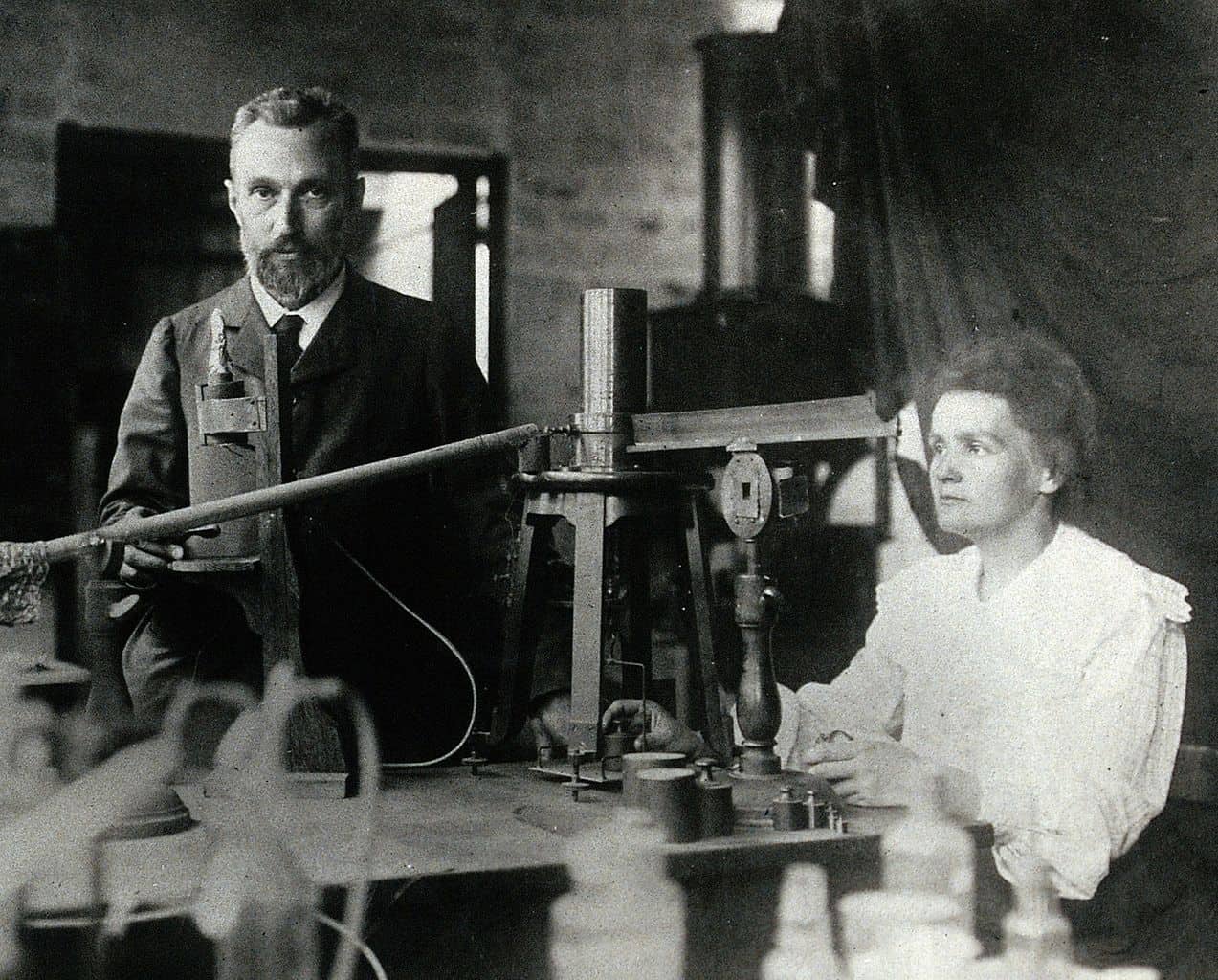
The Nobel Prize is known as the highest award in science. However, how much do we know about these awards? Discover how the Nobel Prize has defined the society’s greatest minds throughout time with these Nobel Prize facts.
- 950 people have been inducted as Nobel Prize laureates as of 2019.
- Nobel Prizes are awarded annually on December 10th.
- A Nobel Prize comes with a cash award of 9 million Swedish krona.
- The United States has the most number of laureates, at 383 people.
- Up to 3 people can share a Nobel Prize award between them.
- The Nobel Foundation founded the Nobel Prize in 1900.
- Wilhelm Röntgen, the discoverer of x-rays, received the first Nobel Prize for Physics in 1901.
- Jacobus van ‘t Hoff received the first Nobel Prize for Chemistry in 1901 for his work on chemical thermodynamics.
- French poet Sully Prudhomme received the first Nobel Prize for Literature in 1901.
- For his development of a diphtheria antitoxin, Emil von Behring received the first Nobel Prize for medicine in 1901.
- Jean Henri Dunant and Frédéric Passy shared the first Nobel Prize for Peace between them in 1901.
- In 1938 and 1939, Adolf Hitler barred 3 German laureates from receiving their prizes.
- The Nobel Foundation did not award any Nobel Prizes during WWII.
- Jan Tinbergen and Ragnar Fritsch shared the first Nobel Prize for Economics in 1968.
- Jean-Paul Sartre became the first person to refuse a Nobel Prize in 1964.
- The Nobel Prize is never given posthumously.
- All awardings except for Nobel Peace take place in Stockholm, Sweden.
- The awarding of the peace prize takes place in Oslo, Norway.
- Up to 3000 people per year become nominees for the Nobel Prize.
- The Nobel Peace Prize is the only one that can be awarded to institutions.
Nobel Prize Facts Infographics

Alfred Noble funded the Nobel Prize through explosives.

Alfred Nobel (1833-1896) was a Swedish chemist, engineer, and inventor. He was especially involved in the weapons industry, with his most memorable invention being dynamite. This led him to get labeled a merchant of death. To fight against that legacy, he ordered the Nobel Foundation founded in his will, with over 90% of his fortune going to the foundation. In that way, he hoped that his legacy would amount to more than making and selling weapons.
Separate academic institutes award the Nobel Prizes.
The Nobel Foundation only nominates and decides who gets the awards for the year. Representatives of different academic institutes award the prizes, as decided by Alfred Nobel in his will. The Royal Swedish Academy of Sciences awards the Nobel Prizes for Physics and Chemistry.
The Karolinska Institute awards the Nobel Prize for Medicine. The Norwegian Nobel Committee awards the Nobel Prize for Peace. Meanwhile, the Swedish Academy awards the Nobel Prize for Literature. Upon its introduction in 1968, the Swedish Academy of Sciences awards the Nobel Prize for Economics.
If a Nobel Prize laureate dies before being awarded, the award will be given to their relatives.
Nobel Prizes aren’t awarded posthumously. However, if the laureate dies after they’re declared the winner for that year, the prize is not withheld. Instead, it’s given to their relatives in their name.
Nobel Prize medals are made of gold.
The Nobel Prizes came in 23-carat gold for those made before 1980. From 1980 to the present, the Nobel Prizes come in 18-carat green gold with 24-carat gold plating. The Swedish Mint made the medals until 2010, followed by the Mint of Norway which makes the medals till now.
Alfred Nobel’s face is on the medal’s reverse side, while the laureate’s name is along the reverse side’s rim. As for the front of the medal, the design depends on what the award is for. However, the front’s rim is uniform with the inscription “Inventas vitam iuvat excoluisse per artes”. Translated from its original Latin into English, it means “It is beneficial to have improved life through discovered arts”.
The medals for physics and chemistry have two figures stamped in the front.
The first figure for the Physics and Chemistry prize is the goddess Isis, holding a cornucopia in one hand, both symbolizing nature. The second figure is a woman representing science, lifting Isis’ veil and exposing her face. This represents genius uncovering the secrets of nature.
The medal for the Nobel Prize in Medicine has a woman and a child stamped in the front.
The Nobel Prize in Medicine features a woman sitting with an open book on her lap, representing medicine. A girl stands next to her, with medicine collecting water from a spring to give to the girl.
The Nobel Prize for Literature medal references Greco-Roman mythology.
The medal for the Nobel Prize in Literature shows a young man symbolizing the artist, sitting under a laurel tree. In Greco-Roman mythology, the laurel tree was holy to Apollo, the god of arts and music. The medal also features one of the muses guiding the artist in his work.

The Nobel Peace Prize has three men stamped in the front.
The Nobel Peace Prize medal features three men with their arms around each other’s shoulders as a symbol of brotherhood. The inscription along the front side’s rim is also different from other medals. It reads “Pro pace et fraternitate gentium”, which means “For the peace and brotherhood of men” when translated from its original Latin into English.
The medal for Nobel Prize in Economic Sciences has a star as its symbol.
This star represents the Swedish Academy of Sciences, which awards the Nobel Prizes for physics, chemistry, and economics. The inscription along the front side’s rim is in Swedish, reading “Sveriges Riksbank till Alfred Nobels Minne 1968”. The Swedish inscription translates to “The Sveriges Riksbank, in memory of Alfred Nobel, 1968.”
This references the introduction of the Nobel Prize for Economics in 1968, at the sponsorship of the Sveriges Riksbank.
Nobel Prize laureates receive their diplomas from the King of Sweden.
In addition to a medal and cash prize, Nobel Prize laureates receive diplomas for their award. The design for each diploma is unique to the laureate receiving it. Aside from the peace prize, all laureates have their diplomas awarded to them by the King of Sweden.
The 1973 Nobel Prize for Peace is one of the most controversial.
In 1973, Henry Kissinger and Lê Đức Thọ received a Nobel Peace Prize for negotiating a ceasefire in the Vietnam War. Two members of the Norwegian Nobel Committee resigned in protest, because fighting continued in Vietnam despite the ceasefire.
Critics denounced Kissinger as worsening the situation as US President Nixon’s National Security Adviser. In contrast, Lê Đức Thọ refused the prize, on the basis that there was still no peace in Vietnam.
Palestinian leader Yasser Arafat’s Nobel Prize for Peace in 1994 also attracted controversy.
While it’s arguable if the Palestinian Liberation Organization (PLO) is a terrorist organization, one of their supporters is Hamas, recognized internationally as a terrorist organization. This led to one member of the Norwegian Nobel Committee to resign in protest, at awarding the peace prize to someone he described as a terrorist leader.

The inventor of lobotomy received a Nobel Prize for Medicine.
As prestigious as the Nobel Prize is, it hasn’t always awarded the best people. Antonio Moniz invented the practice of lobotomy, a surgical procedure where doctors cut out parts of the brain to correct mental illness.
Now, lobotomy is administered only as a last resort treatment. Today’s lobotomy is also far more refined than the previously aggressive process. In the 1950s, tens of thousands of people underwent lobotomy and suffered irreversible brain damage as a result.
Mahatma Gandhi received a nomination for the Nobel Prize for Peace several times.
The first three times were from 1937 to 1939. The fourth time was in 1947, and finally in 1948. After his assassination, members of the Nobel Committee expressed regret that Gandhi never received the peace prize.
Several world-famous writers never received a Nobel Prize despite their achievements.
We’re sure you’ve watched the Lord of the Rings movie series. You could even have read the novels before or after the films. Either way, we’re sure you know how famous J.R.R. Tolkien is. Strange as it seems, he never received the literature prize despite his great work.
Other great authors who never received the literature prize include Leo Tolstoy, Emile Zola, and Mark Twain among others.
The Nobel Prize favors discoveries over inventions.
It’s not that inventors aren’t awarded Nobel Prizes, but Nobel Prizes typically go to scientists first and inventors second. Statistics show that for the physics prize alone, 77% go to scientists, and only 23% is awarded to inventors.
Marie Curie is one of 4 people to receive 2 Nobel Prizes.
She first received the physics prize in 1903, in recognition of her work on radioactivity. She then received the chemistry prize in 1911 for isolating the radioactive element radium. So far, she is the only scientist to receive 2 Nobel Prize awards.

A Russian billionaire once bought a Nobel Prize model.
In 2014, Alisher Usmanov bought Dr. James Watson’s medal at an auction in New York. Dr. Watson held the auction to raise money for cancer research, with Usmanov winning the model for $4.1 million.
To Dr. Watson’s surprise, Usmanov returned the medal after the auction, saying he deserved to keep the medal, and that the $4.1 million should continue to go to cancer research.

Nobel Prize nominees don't get notified.
Up to 3000 people per year are nominated for a Nobel Prize. However, they would only know their status if they win the award. Other than that, they could wait 25 years for the release of the latest nominees.
Anyone can get nominated for the Nobel Prize.
Adolf Hitler, Benito Mussolini, and Joseph Stalin were all Nobel Prize nominees in their time, even if they never knew it. None of them ever won the prize, and it’s no surprise they didn’t.
Was this page helpful?
Our commitment to delivering trustworthy and engaging content is at the heart of what we do. Each fact on our site is contributed by real users like you, bringing a wealth of diverse insights and information. To ensure the highest standards of accuracy and reliability, our dedicated editors meticulously review each submission. This process guarantees that the facts we share are not only fascinating but also credible. Trust in our commitment to quality and authenticity as you explore and learn with us.


